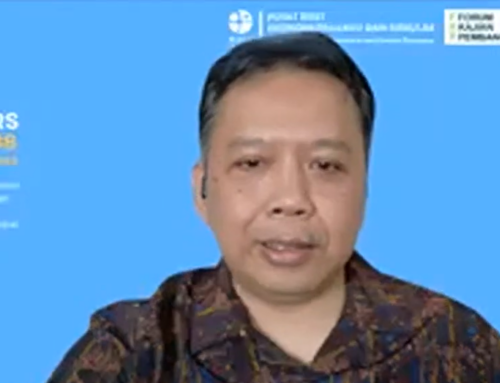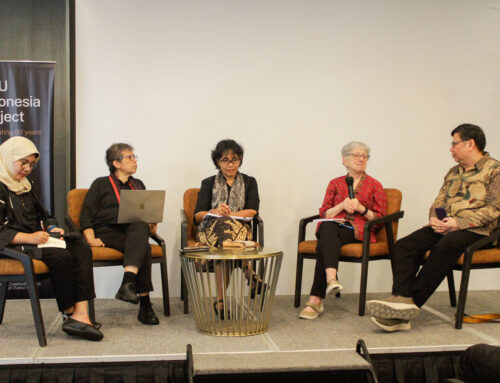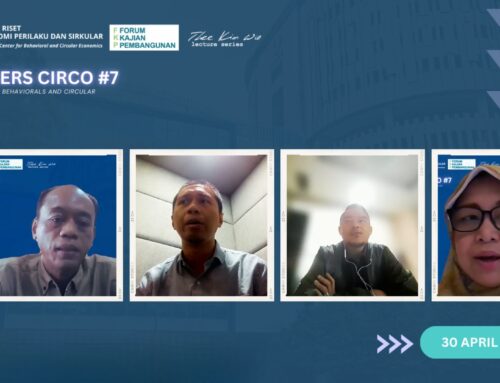The 3rd Thee Kian Wie Lecture was held on 25 April 2018 and the overall theme was the opportunities and challenges of infrastructure development in Indonesia. The speakers were Wahyu Utomo (Deputy Minister for Infrastructure Acceleration and Regional Development, Coordinating Ministry for Economic Affairs), Professor Peter McCawley (The Australian National University), Hidayat Amir (Fiscal Policy Agency, Ministry of Finance), Professor D.S. Priyarsono (Institut Pertanian Bogor), and Siwage Dharma Negara (Center for Economic Research, LIPI). The discussion was guided by Zamroni Salim (LIPI) as moderator.
Wahyu Utomo representer the Coordinating Minister for the Economic Affairs Darmin Nasution, and in his keynote remarks described the current progress of infrastructure development, emphasizing the government’s focus on logistic-based and power-based infrastructure projects which are key role for reducing the cost of logistics in Indonesia. These and projects are listed on Proyek Strategis Nasional (PSN). Through PSN, the government aims to transform Indonesia’s economy into a export-oriented one. Some challenges still facing the implementation of PSN include land-clearing issue, planning strategy, construction execution, legal permission, and financing.
Right to left: Siwage Dharma Negara, Prof. D.S. Priyarsono, Peter McCawley, Wahyu Utomo, Bambang Subiyanto, Hidayat Amir, Agus Eko Nugroho, and Zamroni Salim (credit: Kementerian Keuangan RI)
Professor Peter McCawley summarised his reflections the infrastructure policy in Indonesia into three main points: capital accumulation necessity as a challenge in Asia, infrastructure necessity as a challenge in Indonesia, and the policy framework. On the first point, he emphasized huge, but not yet precisely identified, requirement for capital for infrastructure and other investments. Some Asian countries lack data that differentiate between the flow of investment (i.e. annual investment made) and stock of investment (i.e. capital stock). There are still gaps between capital stock in Asian and OECD countries and this problem should be a priority in the next 10-20 years. Similarly, the lack of date in aggregate infrastructure investment make it harder to measure the real demand for infrastructure in Indonesia. Lastly, Professor McCawley proposed a policy framework to tackle those challenges, and to learn for Australia in building such framework.
Hidayat Amir complemented Professor McCawley’s observation by describing the dilemma faced in policy-making, especially in terms of developing a budget to support current policies. He summarised the challenges into nine dilemmas, and most important of these is the “opposing interests” between the short- and long-term interests. The Indonesia state budget (APBN) is a guidance that resulted from technocratic, political, and governance components. This budgeting collaboration is becoming more complicated as parliamentary, regional, and executive interests collide. The the government is tackling these challenges through various mechanisms including fiscal reform where easier access and good investment climate are hoped to attract investment in public private partnership schemes, thereby reducing dependence on the public budget.
Professor D.S. Priyarsono focused his talk on infrastructure development in marginal areas. Some recent trends in the development indicators show decreasing inequality, increasing infrastructure and increasing resources (e.g. through the village fund) in marginalised areas. However, challenges remain including financing difficulties, inefficient productive programs in marginalized region, difficulties in managing the village fund, and unfinished agrarian reform.
The last speaker, LIPI’s own Siwage Dharma Negara compared the Indonesia infrastructure challanges with China’s Belt Road Initiative (BRI). Through BRI, Indonesia have the opportunity to fill the finance gap. Another benefit from China’s BRI is also the deepening of the bilateral relationship between Indonesia and China, which is needed for regional development and stability. Indonesia has already proposed 12 projects that is related to BRI, spread across Sumatera, Kalimantan, Sulawesi, and Bali. However, BRI opportunities also come with financial, social, environmental and political risks. Indonesia may also become more dependent, and therefore more vulnerable, towards China especially if there is an economic slowdown.
Some news coverage of the event are as follows:
- Badan Kebijakan Fiskal Kementerian Keuangan RI: Seminar 3rd Thee Kian Wie Lecture Series 2018
- Harian Suara: LIPI Akan Gelar The 3rd Thee Kian Wie Lecture Series; Banyak Proyek Strategis Nasional Terhambat Pembebasan Lahan
- Kedaulatan Rakyak Jogja: Fokus Penelitian Tingkatkan Daya Saing Menjadi Negara Maju
- LIPI: 3rd Thee Kian Wie Lecture Series
- Indonesia Development Forum: Mengurai Tantangan Infrastruktur Sebagai Solusi Ketimpangan Ekonomi
- Indo Pos: Tingkatkan Daya Saing Tak hanya Tenaga Kerja Murah
- VOI News: Limited Concession Scheme (LCS) Expected to Provide Big Profit for Indonesia




